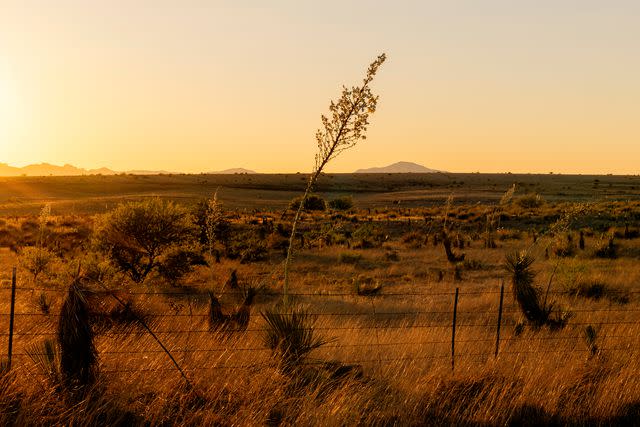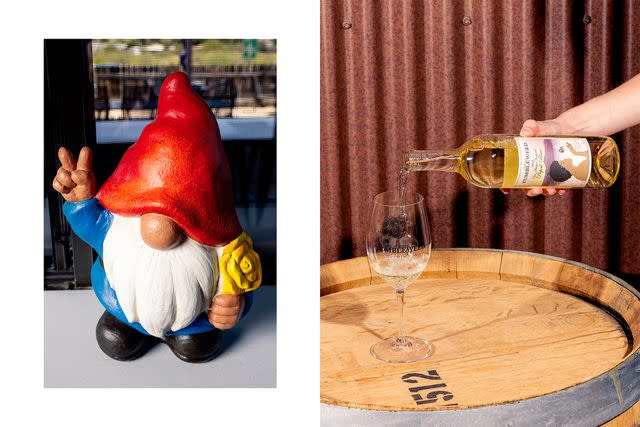Arizona’s Wine Scene Is Booming — Here’s Where to Go and What to Sip
Meet the pioneers putting Arizona wine on the map.

Cassidy Araiza
From left: Grapes on the vine at Los Milics Vineyards, in the Sonoita-Elgin wine region; steel columns greet visitors at Los Milics.As I entered Verde Valley, about 90 miles north of Phoenix, saguaro-studded hillsides gave way to rolling scrubland. The buds had just broken in the high-desert vineyards — a lush start to my early May road trip through Arizona’s wine country.
Friends had been skeptical when I mentioned my latest assignment. “They make wine in Arizona?” came the refrain. But grapevines do grow — and thrive — amid the state’s canyons and cacti, flourishing in a range of microclimates and at elevations of up to 5,500 feet. Temperatures fluctuate dramatically from day to night, fostering sugar development while preserving natural acidity. At the same time, winemakers navigate challenges like heavy summer rains, spring frost, and vine crushing hail.
Few casual consumers know Arizona’s wine story yet, despite its roots stretching back to 16th-century Spanish missionaries. In the 1880s, German immigrant Henry Schuerman planted Zinfandel along Verde Valley’s Oak Creek; he sold his wine to cattle hands and copper miners. Pro-prohibition legislation slowed production from 1915 until the 1970s, when University of Arizona soil scientist Gordon Dutt planted test vineyards in the high desert. The results looked promising, and Arizona’s modern-day wine industry began.
I’d come to meet trailblazing vintners in two of the state’s American Viticultural Areas (AVAs), or federally recognized wine regions: Verde Valley, a newcomer established in late 2021; and, farther south, Sonoita-Elgin, established in 1983.

Cassidy Araiza
Caduceus Cellars' high-desert vines in Verde Valley.Verde Valley
My education began at Chateau Tumbleweed, where cofounder Joe Bechard explained why the state doesn’t hang its hat on a single grape. “We’re really experimental here,” Bechard told me. “It’s a lot of trial and error, especially with the whites, but it’s that spirit of discovery that draws me in.” For Bechard, that has involved tinkering with varieties like Aglianico, Graciano, and Sangiovese, which express the desert terroir beautifully.
I sipped a 2022 Picpoul Blanc, a single-varietal white, with Kris Pothier, another Tumbleweed cofounder. Fresh and smooth, with bright pops of citrus, it was perfect for a desert afternoon. “Arizona winemakers work with so many different varietals,” she said, giving the flaxen liquid a swirl. “As climate change starts to impact what people can grow around the world, I think we’re a strong example of what works in hot, arid climates.”
To learn more, I visited Yavapai College’s Southwest Wine Center, which offers immersive “vineyard-to-bottle” programs at its 13-acre teaching vineyard and wine-making facility. I tried a student-crafted flight, which ranged from an apricot-scented Viognier to a bold Grenache-Tempranillo blend, with viticulture and enology director Michael Pierce. “The best thing about wine making in Arizona,” Pierce said, “is that this isn’t a place where you get pigeonholed stylistically.”

Cassidy Araiza
From left: A glimpse of downtown Cottonwood; grapes are a common motif in Old Town Cottonwood, which is surrounded by wine country.In the town of Cottonwood, about an hour’s drive east of Prescott, I checked in to the Tavern Hotel, a boutiquey, wine-themed property on Main Street. Each day, after a morning hike, I cruised between Clarkdale, Cornville, and Jerome — the Valley’s main hubs — choosing from a hit parade of wineries and tasting rooms.
I met Maynard James Keenan, a Verde Valley wine pioneer, at his forthcoming project, the Caduceus Cellars & Merkin Vineyards Hilltop Facility. We stood overlooking Cottonwood’s old town. “I’m exhausted by the ‘can they make wine in Arizona?’ question,” Keenan said. “We’re making world-class wine.”
When the complex opens this fall, it will house a production space, a farm-to-table restaurant, and a room for exclusive tastings that Keenan likens to an omakase experience. The 4½ acres of grapevines, which include Graciano and Tempranillo, are growing strong.

Cassidy Araiza
Golden hour in Arizona's Sonoita-Elgin wine region.Sonoita-Elgin
The next morning I headed south. In Sonoita, I dropped my bags at Casa NextDoor @ Dos Cabezas, an invitingly rustic Airbnb adjacent to Dos Cabezas WineWorks. Over wood-fired pizzas on Dos Cabezas’s patio, winemaker Todd Bostock gave me his highlight reel of wines, starting with Prínciprana: a traditional-method sparkling white blend of Garnacha, Riesling, and Tempranillo. Part of the region’s old guard, Bostock came on the scene in 2002. Now he and his wife, Kelly, have 52 acres under vine in Sonoita and Willcox, the third of Arizona’s AVAs.
Ten minutes from Dos Cabezas, the weathered-steel columns of Los Milics Vineyards rose up from the high desert like something from a science-fiction film set. Founder Pavle Milic also co-owns the acclaimed restaurant FnB, in Scottsdale, where he has showcased Arizona wines from the get-go. It’s been a leap of faith that earned FnB James Beard Award semifinalist spots for Outstanding Wine Program in 2017 and 2020. “Arizona wines are interesting,” Milic said. “They dance in this nebulous place between Old World and New.”

Cassidy Araiza
From left: A garden gnome at Chateau Tumbleweed winery, in the Verde Valley; pouring a glass of Picpoul Blanc at Chateau Tumbleweed.I spent my last afternoon at Rune Wines, where James Callahan’s varietals celebrate the magic of wild-yeast fermentation. “For the first twenty or so years of Arizona wine making, everyone was experimenting,” he said, pouring me a glass of Rune’s flagship Wild Syrah. “Now we just need to get our wine in front of people.”
I swirled and sipped, soaking in the view. Neat rows of vines, their leaves chartreuse with spring growth, met the untamed beauty of the high-desert grasslands. In the distance, the Mustang Mountains loped across the horizon. Arizona’s wine story may still be unsung, but I knew, with absolute certainty, that wouldn’t be the case for long.
A version of this story first appeared in the October 2023 issue of Travel + Leisure under the headline "Desert Bloom."
For more Travel & Leisure news, make sure to sign up for our newsletter!
Read the original article on Travel & Leisure.

